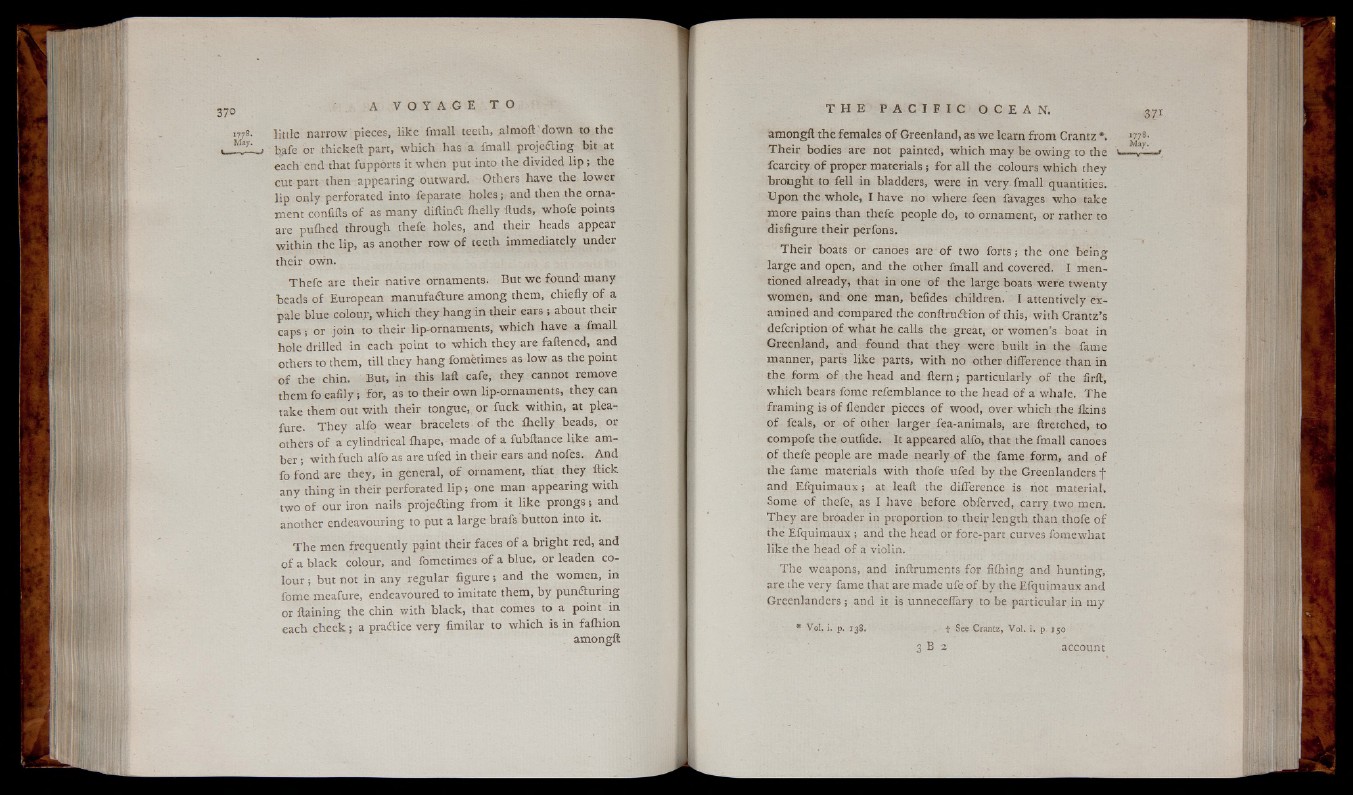
1778. little narrow pieces, lik e fin all teeth, almoft down to the
. l^afe or thickeft part, w h ich has a fmall projefting bit at
each end that fupports it when put into the divided lip ; the
cut part then appearing outward. Others have the lower
lip only perforated into feparate h o le s ; and then the ornament
confifts o f as many diftinCt fhe lly ftuds, whofe points
are pufhed through thefe holes, and their heads appear
within the lip, as another row o f teeth immediately under
their own.
T he fe are their native ornaments. But w e fo u n d many
beads o f European manufacture among them, chiefly o f a
pale blue colour, which they han g in their ears ; about their
c a p s ; or join to their lip-ornaments, w hich have a fmall
hole drilled in each point to w h ich they are fattened, and
others to them, till they han g fometimes as low as the point
o f the chin. But, in this laft cafe, they cannot remove
them fo e a fily ; for, as to their own lip-ornaments, they can
take them out w ith their tongue,, or fu c k within, at plea-
fure. T h e y alfo wear bra ce le ts -o f the fhe lly beads, or
others o f a cylindrical fhape, made o f a fubftance Hke amber
; w ith fu ch alfo as are ufed in their ears and nofes. And
fo fond are they, in general, o f ornament, that they flick
any thing in their perforated l ip ; one man appearing w ith
two o f our iron nails projecting from it lik e p ro n g s ; and
another endeavouring to put a large brafs button into it.
T h e men frequently paint their faces o f a b right red, and
o f a bla ck colour, and fometimes o f a blue, or leaden colour
; but not in any regular f ig u r e ; and the women, in
fome meafure, endeavoured to imitate them, b y puncturing
or ftaining the chin with black, that comes to a point in
each c h e e k ; a practice ve ry fimilar to w hich is in fafhion
amongft
amongft the females o f Greenland, as we learn from Crantz *, ■778-
T h e ir bodies are not painted, w hich may be ow in g to the t- ■
fear city o f proper m a te ria ls ; fo r all the colours w hich they
brought to fell in bladders, were in very fmall quantities.
Upon the whole, I have no where feen favages who take
more pains than thefe people do, to ornament, or rather to
disfigure their perfons.
T h e ir boats or canoes are o f two fo r t s ; the one being
la rge and open, and the other fmall and covered. I mentioned
already, that in one o f the large boats were twenty
women, and one man, befides children. I attentively examined
and compared the conftruClion o f this, with Crantz’s
defcription o f what he calls the great, or women’s boat in
Greenland, and found that they were built in the fame
manner, parts lik e parts, with no other difference than in
the form o f the head and ftern; particularly o f the firft,
w h ich bears fome refemblance to the head o f a whale. The
fram in g is o f flender pieces o f wood, over which the ikins
o f feals, or o f other larger fea-animals, are ftretched, to
compofe the outfide. It appeared alfo, that the fmall canoes
o f thefe people are made nearly o f the fame form, and o f
the fame materials with thofe ufed b y the Greenlanders f
and E fq u im au x ; at leaft the difference is not material.
Some o f thefe, as I have before obferved, carry two men.
T h e y are broader in proportion to their length than thofe o f
the E fq u im au x ; and the head or fore-part curves fomewhat
lik e the head o f a violin.
The weapons, and inftruments fo r fifhing and hunting,
are the very fame that are made ufe o f by the Efquimaux and
Greenlanders ; and it is unneceffary to be particular in my
* V o l. i. p. 138. . t See Crantz, V o l. i. p. 150
3 B 2 account